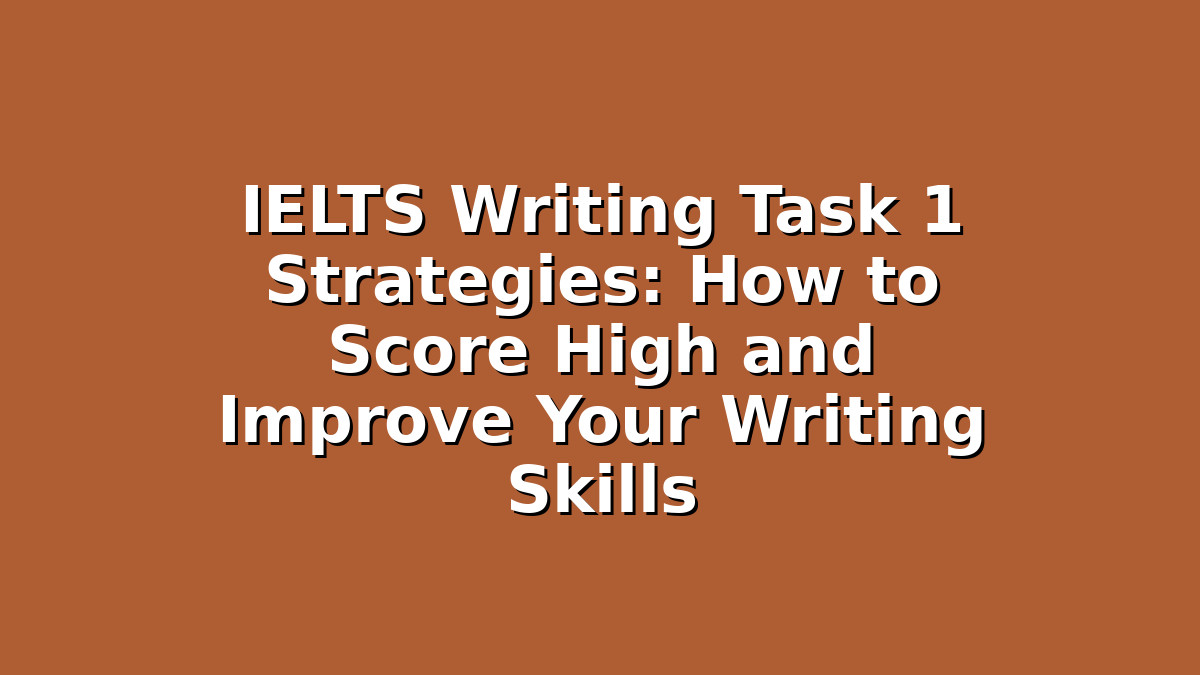Preparing for the IELTS exam can feel overwhelming, especially when it comes to the Writing Task 1 section. Whether you are a student aiming to study abroad, apply for a job, or migrate, achieving a high score in IELTS Writing Task 1 is essential. This part of the exam tests your ability to interpret visual information such as graphs, charts, tables, and diagrams, and then summarize the data clearly and coherently. If you want to boost your confidence and improve your writing skills, knowing effective strategies for IELTS Writing Task 1 is key.
In this article, we will explore practical and proven strategies to help you excel in IELTS Writing Task 1. We’ll cover how to understand the task, organize your writing effectively, and practice smartly to maximize your score. By following these tips, you’ll develop a strong foundation and writing approach that will serve you well on test day.
—
Understanding the IELTS Writing Task 1 Requirements
Before diving into writing, it’s essential to clearly understand what IELTS Writing Task 1 entails. You will be given one or more visual representations of information—such as a bar chart, line graph, pie chart, table, or a process diagram. Your task is to write at least 150 words summarizing the key information in a formal and objective style. You need to describe trends, comparisons, and significant details without giving your opinion.
Key points to remember:
– Task Achievement: You must fully address all parts of the prompt by selecting and reporting the most important information.
– Coherence and Cohesion: Your writing should be logically organized with clear connections between ideas.
– Lexical Resource: Use a variety of vocabulary and avoid repetition.
– Grammatical Range and Accuracy: Correct grammar and sentence structures make your writing easier to understand.
To prepare effectively, practice identifying the main features of different types of visuals. Ask yourself: What stands out? Are there any notable increases, decreases, or patterns? Which comparisons are most relevant?
—
Organizing Your Response: A Simple Structure for Success
One of the biggest challenges students face is how to organize their response clearly within the 20 minutes allocated for Writing Task 1. Using a consistent structure can help you stay on track and cover everything the examiner expects.
Here’s a reliable, easy-to-follow structure:
1. Introduction (paraphrase the question prompt)
Start by restating the topic in your own words. This shows the examiner you understand what’s being asked and sets the tone for your summary.
2. Overview (summary of the main trends or key information)
Identify 2-3 major trends or key points that stand out. This section is crucial because the examiner looks for your ability to highlight the most important information without unnecessary details.
3. Body Paragraphs (detailed description and comparisons)
Divide this part into 1 or 2 paragraphs where you describe the data in detail. Group similar information together and make comparisons where relevant. Use linking words such as “however,” “in contrast,” “similarly,” and “as a result” to connect ideas smoothly.
Example:
– Introduction: The graph illustrates changes in population growth rates in three countries between 2000 and 2020.
– Overview: Overall, Country A showed consistent growth, while Country B experienced a decline, and Country C remained stable.
– Body Paragraph 1: Details about Country A and Country B trends.
– Body Paragraph 2: Details about Country C and any comparisons.
Using this structure helps you write logically and ensures you don’t miss important points.
—
Effective Study Tips to Improve Your Writing Skills
To perform at your best, consistent practice combined with smart study habits is essential. Here are three powerful tips to enhance your IELTS Writing Task 1 preparation:
1. Practice with a Variety of Visuals
Don’t limit yourself to just line graphs or bar charts. Practice describing pie charts, tables, and process diagrams as well. Each type requires slightly different language and focus. Familiarity with all formats will increase your confidence and flexibility during the exam.
2. Build Your Vocabulary and Sentence Structures
Learn specific phrases and vocabulary related to describing data, such as “a significant increase,” “a gradual decline,” “remained steady,” or “accounted for the largest proportion.” Also, practice using different sentence types like comparatives, superlatives, and passive constructions. This variety makes your writing more engaging and meeting higher band criteria easier.
3. Time Yourself and Get Feedback
Writing under timed conditions simulates the real test environment and helps improve your speed. Aim to complete Task 1 within 20 minutes. After writing, compare your response to high-scoring sample answers or get feedback from teachers, tutors, or online communities. Understanding your mistakes and correcting them is one of the fastest ways to improve.
Additionally, reading IELTS Task 1 sample answers and official band descriptors will give you a clear idea of what examiners expect.
—
Conclusion: Stay Positive and Keep Improving
IELTS Writing Task 1 may seem challenging at first, but with the right strategies and consistent practice, you can definitely improve your score and writing skills. Remember to focus on fully understanding the task, organizing your response clearly, and practicing different types of visuals regularly. Build your vocabulary and sentence variety, and always review your work critically to learn from your mistakes.
Stay motivated, be patient with your progress, and keep using these strategies daily. Every effort you put in brings you closer to your goal of achieving a high IELTS band score. Good luck on your IELTS journey—you’ve got this!
—

Responses